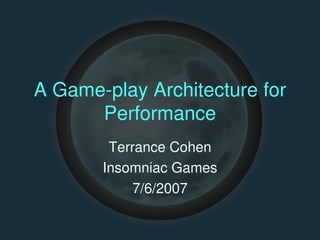
A Game-play Architecture for Performance
- 1. A Gameplay Architecture for Performance Terrance Cohen Insomniac Games 7/6/2007
- 2. Outline • Preface • Case study: Resistance GP Optimization – Drones – Aspects experiment Cell Performance – High Level • Aspects for Performance – a Proposal • Summary • Moderated Discussion •
- 3. Preface • Qualifications? – Performance considerations for gameplay • Not what we’re used to – Comments encouraged • Looking to the future • Many variations possible within the proposed framework *
- 4. Resistance GP Optimization – Problem Statement • AI and Move were expensive • Profile was pretty flat, ie. few hotspots • Deferred targeting collision checks – small improvement • Designer contributions – Limited effect – Too laborintensive to be a generalpurpose solution “Massive Monolithic Updates are Bad.”
- 5. Resistance GP Optimization – the Technique • Decided to implement Drones – Very cheap (by comparison) but Convincing – No AI or Move • Abilities Select target – Shoot – Cover (low or medium, but not full) – Die – Promote – • Drones could not relocate *
- 6. Resistance GP Optimization – Drone Planning • Who is a Drone and when • Desired population – 3 “Affinities”: No, Medium, High – Fill from High Affinity if possible – If desired population can’t be filled with High Affinity candidates, use Low Affinity ones – Never demote No Affinity candidates • For Resistance, A(moby) = f(distance) – 2 distances fully specify Affinity Zones *
- 7. Resistance GP Optimization – Drone Planning (cont’d) • Promotion triggers When is a Drone not a Drone? – Damaged by player – Zoomedin on – No Affinity (part of Planning) – Timed, randomized interval – • Planning updated continuously • Planning data – 2 Affinity Zone border distances, Desired % – Global (level) planning – Optional persquad planning override
- 8. Resistance GP Optimization – Results Drones were ~ 10% of the cost • Planning worked well • Squad planning data used rarely • With planning, affinity, and promotion • triggers, Drones are barely noticeable • A few scenarios still needed to be trimmed • AI & Move fit in budget
- 9. Proposal: Aspects for Performance • Idea of Aspects taken from Aspect Oriented Programming – Help programmers in the separation of concerns: – Breaking down a program into distinct parts that overlap in functionality as little as possible • Consider the highlevel elements of Cell performance
- 10. Cell Performance High Level • Weakness – High penalties for cache miss and mispredicted branches • Strength – Parallelism! • Approach: – Separate concerns, run them in parallel – Goals match AOP! • These factors are likely to be more prominent in future hardware
- 11. Proposal: Aspects for Performance Systems own their data (instead of mobys) • When a System updates, it tears through its data • Systems could work in parallel with other systems • Tighter loops with fewer conditionals and less • branching – No need to test if a Game Object has a particular type of data to update • Context switches are always expensive! • Systems operating on local data can operate more efficiently
- 12. Proposal: Aspects for Performance • Infrastructure for Drones exercise in AOP • We’ve been heading in that direction! Components – Physics Instances – Update Classes (to an extent) – Anim Manager – • Tools have moved toward Assets – Lends itself well to Aspects
- 13. Proposal: Aspects for Performance • Ultimately, GameObject is just a container – The container is no longer necessary! • Game Objects would exist only as IDs on Aspect instances • Query API: – Aspect* GetAspect(AspectType, GameObject ID) • Not allornothing – gradual transition is straightforward
- 14. Aspects for Performance Current Technique • Components – Abstract interface to Game Objects – Encourages synchronous processing
- 15. Aspects for Performance Looking Forward • Aspects – Dynamically adding/removing Aspects supported in a unified way – Systems own their data, processing is cache friendly, encourages asynch processing – No overhead querying for Components
- 16. AOGD Thought Experiments • How granular should aspects be? • Should they be hierarchical or flat? • Consider forming a state machine out of Aspects – State transitions replace the current state aspect with another – State initialized when Aspect added – Support for simultaneous states – States communicate via shared Blackboard (effectively member data) (like “dynamic pvars”)
- 17. AOGD Thought Experiments • New ways of visualization / analysis • Cool Aspect Analysis screens: – Aspects by owner (Game Object ID) • Point at Game Object and see his Aspects • Select an aspect and see its properties & values – Aspects could implement a DebugDump method – To TTY or to Viewport – Aspects by System w/ owner – Pivot data
- 18. Aspects for Performance Misc. Considerations • Sharing data between Aspects – “crosscutting concerns” in AOP lingo – Implement as systems see fit • Shared Data uploaded with multiple systems • System refers to data owned by other system • Debugging – Effectively the same as before • Debugging the affected system – Debugger scripting could assist in locating objects within other systems
- 19. Summary Drones were a very effective optimization • Provided a limited test of Aspects • Cell performance demands parallelism • Aspect oriented game development plays • directly into the strengths and weaknesses of the Cell